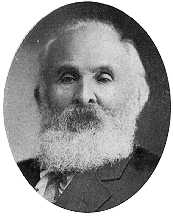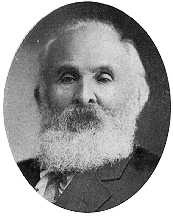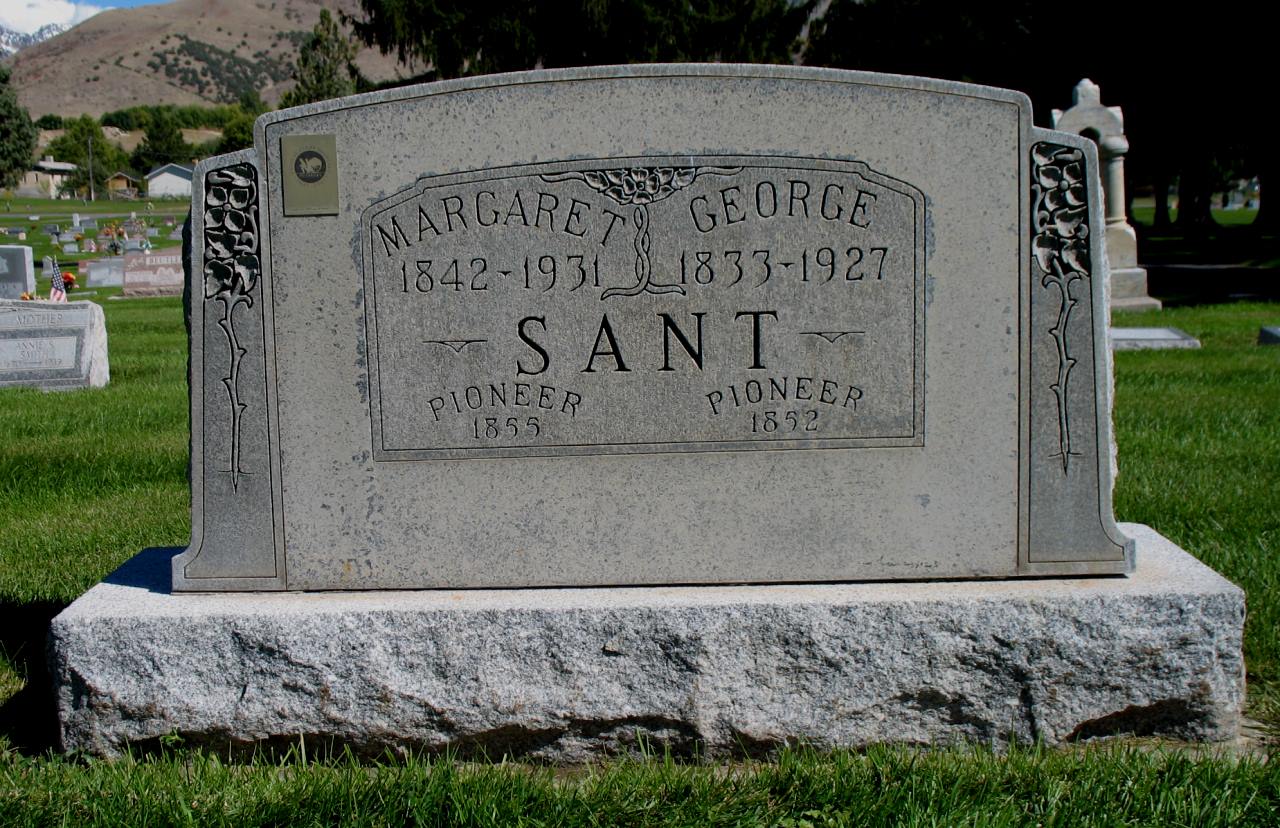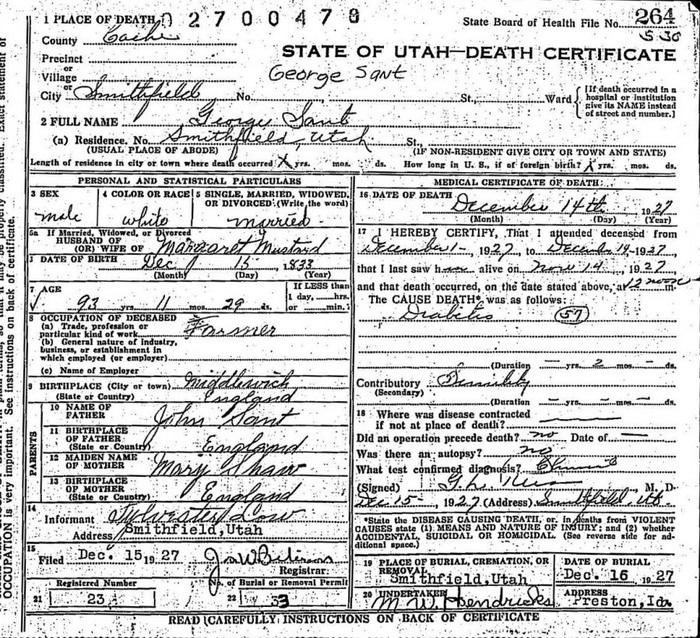Married Margaret Kay Mustard, 20 Oct 1858, Cedar City, Iron, Utah
Married Ann Treasure, 13 August 1869, Salt Lake City, Salt Lake, Utah
GEORGE SANT - (Life Story in His Own Words), b. 1833
George Sant and his wife Margaret, of Smithfield, have the distinction of being about the oldest couple now living in this county. They are pioneers, not only of Cache County but of Utah as well. They have had their part in the trials common to all in those early pioneer days, and with the others have suffered hunger, poverty, fatigue, and want, in their efforts to subdue the desert. While Mr. Sant’s frame is bent and his body shriveled with the weight of years, yet his mind is clear, and he remembers distinctly the events of eighty years ago. We will tell his story as nearly as we can in his own words.
"I was born in December 15, 1833 in Middlewich, Chestershire, England. About 1845, Elder Thomas McCann came to our house and preached the gospel. Father was converted, but mother was very bitter, and threatened to scald Brother McCann unless he left the place. Her prejudice soon wore off and she accepted the gospel later. I was baptized in l848 by Samuel Drinkwater.
"I came to America in 1854. We left Liverpool Monday, November 27, 1854, on board the ship Clara Wheeler. • There were 422 Saints on board. Henry E. Phillips had charge of the company. We put to sea, but a storm came up and we had to turn back into the harbor where we laid for seven days. We then set sail and had a fairly good voyage to New Orleans, where we arrived January 11, 1855.
"We took steamboat for St. Louis where we arrived January 22. We stayed in St. Louis until May 10 when we took a boat up the Missouri river for Mormon Grove near Atchinson, Kansas. There we secured teams and wagons for the long journey across the plains. I drove four yoke of cattle for Peter Burgess. John Hindley was our captain. We left Mormon Grove about June 10. There were 46 wagons and 200 Saints. We reached Salt Lake September 3. I went to live with a Mr. Sutton. Later, I went to Iron County with David Muir to work in the iron mill there.
"For a time I got work in a grist mill with James Boswell. Then I went to live with William Mitchel at Parowan, I was at Hamilton’s Fort when the massacre took place at Mountain Meadow. Johnson’s army came that fall and I went with Eliezer Edwards to Toquerville, where we were to leach the scraping of the cave floors to obtain saltpeter to make gunpowder. We built vats and washed the scrapings and ran the sa1tpeter in the other vats to crystallize. We then went to the sulphur mines near Beaver and got sulphur. We burned charcoal to mix with the powder. Later, I was sent to the iron mill where I worked as feeder for eighteen months. We ran the iron into bars which were sent to Salt Lake.
“While I was in Cedar City I was sent with a company with teams to move the people of Salt Lake south, during the great move. James Williamson of Wellsville was our captain. In my wagon was a young lady named Margaret Mustard, to whom I became attached and we married on our arrival at Cedar City October 2, 1885. Isaac C. Haight performed the ceremony. We commenced housekeeping in a little dugout. We had hardly anything to keep house with. We mixed our bread in a wooden box, and baked it on a hot rock in front of the fire. We had two pottery plates and a pitcher. We often drank bran coffee without sugar or milk. Our bed was of straw, without a tick, laid down on the floor. We had only two quilts. While working at the mill my meals mostly consisted of scalded cakes and water. We moved to Hamilton’s Fort in the spring of 1859. Our first baby was born that fall. In December, we went to Beaver and then to Salt Lake to live with my wife's mother.
"In 1860, I hired to Ezra G. Williams, a son of Fredrick G. Williams, the first historian of the church. We came with him to Cache County. We located Summit April 15, 1860. I worked for Mr. Williams that summer. I also managed to build a little cabin in the fort, and cultivated a garden. Our cabin had a dirt floor and a dirt roof. We did our cooking in a fire place.
"In 1864, I was called to go to Bear Lake to help settle the valley. We went as early in the spring as we could. I raised a small crop that summer. In December, I went to Logan to get a grist ground. We had to wait for it two weeks and when we started back, it had begun to snow. When we reached the divide beyond Mink Creek we found the snow so deep that we had to shovel a road over the summit and down into the canyon below." (All old settlers of Bear Lake will remember the long steep hill and the hard climb to the summit. Everyone had grief there. How Mr. Sant got up with a loaded wagon in three or four feet of snow, we can only imagine. It was bad enough when the ground was bare.)
"We returned to Smithfield in 1865, where we remained until 1871 when we went to Treasureton where we lived for 35 years. My father and mother and family came to Utah in 1861, while we were living in the old fort in our one room cabin. We all lived in one small room that winter, 13 of us."
GEORGE SANT DIES AT 94 YEARS OF AGE
(from a newspaper clipping at time of death)
George Sant of Smithfield, pioneer, died of old age at his home here Wednesday, December 14 [1927], at 11 a,m. the day before his 94th birthday anniversary which the family was preparing to celebrate, but he slept peacefully away first.
Beside his widow Margaret Sant he is survived by the following children: Mary Ellen Thomas, Shelley, Idaho; George Sant Jr., Mrs. Eliza Johnson, and David Sant of Treasureton; and Mrs. Margaret K. Smith of Cleveland, Idaho, all children of Margaret Sant. Thomas J. Sant of Clifton, Idaho; Albert Sant, Seth Sant, Preston Sant, Frank Sant, all of Grace, Idaho; Elmer Sant and Elmo Sant of Seattle, Washington, and Elsie Howell of Clifton, Idaho.
George Sant, son of John Sant and Mary Shaw Sant, was born December 15, 1833 in Middlewich, Cheshire, England. He joined the L.D.S. Church in January 1848, was baptized by Samuel Drinkwater January 17, 1848. He worked with his father on a canal boat until he was 21. He saved enough money to come to America, and sailed from Liverpool in the ship Clara Wheeler in company of 452 Saints under the direction of Henry E. Phelps. The company arrived in New Orleans January 11, 1855 and in Salt Lake City September 3, 1855 with 46 wagons and 200 souls.
Before leaving England he promised Franklin D. Richards he would go to Iron County to work on the Iron Works, the first in Utah, but times were hard in that county at that time. He lived in Cedar City, was often called with others to stand guard to protect the citizens from the Indians. He married Margaret Mustard October 2, 1858. In the winter of 1859, he went to Salt Lake. In 1880 he was hired to Dr. Ezra G. Williams and came to Summit Creek, where he was one of the first settlers and assisted in building the old Fort. He also assisted in building canals, meeting houses and such work required of the early settlers. It was here during the Indian troubles that two men were killed and one wounded. He left Summit, later called Smithfield and with others was called to settle Bloomington, Bear Lake Valley. Here he built a home and planted a crop but it was frozen. He then returned to Smithfield in 1865. Married Ann Treasure in 1869. In 1871 moved to Idaho and. settled a place now called Treasureton. In 1885 moved to Star Valley where he resided about 10 years then returned to Treasureton. In 1901 came tack to Smithfield among his old friends. He was the father of 23 children, 211 grand children and great grand children, and 11 great-great-grand children.
A fitting tribute was paid to the memory of George Sant at the funeral services held in the Third Ward Chapel Friday in charge of Bishop Richard Roskelley. There was a good attendance notwithstanding the storm and fact that many had not received word of the time of the funeral. The ward choir assisted by members of second ward choir sang appropriate songs, directed by Sadie McCracken, with Mrs. Emma H. Hansen at the organ. Special songs were: Solo, "My Faith in Thee" by Mrs. Regenia Smith; Quartette, "Looking This Way," Mrs. Emma Thornley, Sadie McCracken, James Thornley and Bishop Richard Roskelley, and a solo, Mrs. W. H. Griffiths. It was stated that the songs were favorites of the deceased, who was at one time a choir member. Sons and Grandsons were pall bearers. The beautiful flowers were in charge of the ladies of the family. [sic]
"O My Father" was the opening song, and Preston D. Thomas, a grandson offered the invocation, followed by the choir singing, "I’ll Praise My Maker." The following speakers eulogized the life and character of the deceased, Lester Sant, a grandson; Samuel Nelson, an early pioneer; Sylvester Lowe; Thomas Sant, youngest and only surviving brother, and Bishop Richard Roskelley. Each spoke of George Sant as a typical pioneer, a man of "steel" in character and endurance, of the places in Utah and Idaho he had, helped to colonize, of his cheerful disposition and how he won the favor of all with whom he came in contact even to the Indians in early days. His numerous posterity numbered 319 at the time of his death.
"Farewell All Earthly Honor" was the closing song, and benediction was offered by Russell Johnson, a grandson. Interment took place in the Smithfield City Cemetery.
Married Margaret Kay Mustard, 20 Oct 1858, Cedar City, Iron, Utah
Married Ann Treasure, 13 August 1869, Salt Lake City, Salt Lake, Utah
GEORGE SANT - (Life Story in His Own Words), b. 1833
George Sant and his wife Margaret, of Smithfield, have the distinction of being about the oldest couple now living in this county. They are pioneers, not only of Cache County but of Utah as well. They have had their part in the trials common to all in those early pioneer days, and with the others have suffered hunger, poverty, fatigue, and want, in their efforts to subdue the desert. While Mr. Sant’s frame is bent and his body shriveled with the weight of years, yet his mind is clear, and he remembers distinctly the events of eighty years ago. We will tell his story as nearly as we can in his own words.
"I was born in December 15, 1833 in Middlewich, Chestershire, England. About 1845, Elder Thomas McCann came to our house and preached the gospel. Father was converted, but mother was very bitter, and threatened to scald Brother McCann unless he left the place. Her prejudice soon wore off and she accepted the gospel later. I was baptized in l848 by Samuel Drinkwater.
"I came to America in 1854. We left Liverpool Monday, November 27, 1854, on board the ship Clara Wheeler. • There were 422 Saints on board. Henry E. Phillips had charge of the company. We put to sea, but a storm came up and we had to turn back into the harbor where we laid for seven days. We then set sail and had a fairly good voyage to New Orleans, where we arrived January 11, 1855.
"We took steamboat for St. Louis where we arrived January 22. We stayed in St. Louis until May 10 when we took a boat up the Missouri river for Mormon Grove near Atchinson, Kansas. There we secured teams and wagons for the long journey across the plains. I drove four yoke of cattle for Peter Burgess. John Hindley was our captain. We left Mormon Grove about June 10. There were 46 wagons and 200 Saints. We reached Salt Lake September 3. I went to live with a Mr. Sutton. Later, I went to Iron County with David Muir to work in the iron mill there.
"For a time I got work in a grist mill with James Boswell. Then I went to live with William Mitchel at Parowan, I was at Hamilton’s Fort when the massacre took place at Mountain Meadow. Johnson’s army came that fall and I went with Eliezer Edwards to Toquerville, where we were to leach the scraping of the cave floors to obtain saltpeter to make gunpowder. We built vats and washed the scrapings and ran the sa1tpeter in the other vats to crystallize. We then went to the sulphur mines near Beaver and got sulphur. We burned charcoal to mix with the powder. Later, I was sent to the iron mill where I worked as feeder for eighteen months. We ran the iron into bars which were sent to Salt Lake.
“While I was in Cedar City I was sent with a company with teams to move the people of Salt Lake south, during the great move. James Williamson of Wellsville was our captain. In my wagon was a young lady named Margaret Mustard, to whom I became attached and we married on our arrival at Cedar City October 2, 1885. Isaac C. Haight performed the ceremony. We commenced housekeeping in a little dugout. We had hardly anything to keep house with. We mixed our bread in a wooden box, and baked it on a hot rock in front of the fire. We had two pottery plates and a pitcher. We often drank bran coffee without sugar or milk. Our bed was of straw, without a tick, laid down on the floor. We had only two quilts. While working at the mill my meals mostly consisted of scalded cakes and water. We moved to Hamilton’s Fort in the spring of 1859. Our first baby was born that fall. In December, we went to Beaver and then to Salt Lake to live with my wife's mother.
"In 1860, I hired to Ezra G. Williams, a son of Fredrick G. Williams, the first historian of the church. We came with him to Cache County. We located Summit April 15, 1860. I worked for Mr. Williams that summer. I also managed to build a little cabin in the fort, and cultivated a garden. Our cabin had a dirt floor and a dirt roof. We did our cooking in a fire place.
"In 1864, I was called to go to Bear Lake to help settle the valley. We went as early in the spring as we could. I raised a small crop that summer. In December, I went to Logan to get a grist ground. We had to wait for it two weeks and when we started back, it had begun to snow. When we reached the divide beyond Mink Creek we found the snow so deep that we had to shovel a road over the summit and down into the canyon below." (All old settlers of Bear Lake will remember the long steep hill and the hard climb to the summit. Everyone had grief there. How Mr. Sant got up with a loaded wagon in three or four feet of snow, we can only imagine. It was bad enough when the ground was bare.)
"We returned to Smithfield in 1865, where we remained until 1871 when we went to Treasureton where we lived for 35 years. My father and mother and family came to Utah in 1861, while we were living in the old fort in our one room cabin. We all lived in one small room that winter, 13 of us."
GEORGE SANT DIES AT 94 YEARS OF AGE
(from a newspaper clipping at time of death)
George Sant of Smithfield, pioneer, died of old age at his home here Wednesday, December 14 [1927], at 11 a,m. the day before his 94th birthday anniversary which the family was preparing to celebrate, but he slept peacefully away first.
Beside his widow Margaret Sant he is survived by the following children: Mary Ellen Thomas, Shelley, Idaho; George Sant Jr., Mrs. Eliza Johnson, and David Sant of Treasureton; and Mrs. Margaret K. Smith of Cleveland, Idaho, all children of Margaret Sant. Thomas J. Sant of Clifton, Idaho; Albert Sant, Seth Sant, Preston Sant, Frank Sant, all of Grace, Idaho; Elmer Sant and Elmo Sant of Seattle, Washington, and Elsie Howell of Clifton, Idaho.
George Sant, son of John Sant and Mary Shaw Sant, was born December 15, 1833 in Middlewich, Cheshire, England. He joined the L.D.S. Church in January 1848, was baptized by Samuel Drinkwater January 17, 1848. He worked with his father on a canal boat until he was 21. He saved enough money to come to America, and sailed from Liverpool in the ship Clara Wheeler in company of 452 Saints under the direction of Henry E. Phelps. The company arrived in New Orleans January 11, 1855 and in Salt Lake City September 3, 1855 with 46 wagons and 200 souls.
Before leaving England he promised Franklin D. Richards he would go to Iron County to work on the Iron Works, the first in Utah, but times were hard in that county at that time. He lived in Cedar City, was often called with others to stand guard to protect the citizens from the Indians. He married Margaret Mustard October 2, 1858. In the winter of 1859, he went to Salt Lake. In 1880 he was hired to Dr. Ezra G. Williams and came to Summit Creek, where he was one of the first settlers and assisted in building the old Fort. He also assisted in building canals, meeting houses and such work required of the early settlers. It was here during the Indian troubles that two men were killed and one wounded. He left Summit, later called Smithfield and with others was called to settle Bloomington, Bear Lake Valley. Here he built a home and planted a crop but it was frozen. He then returned to Smithfield in 1865. Married Ann Treasure in 1869. In 1871 moved to Idaho and. settled a place now called Treasureton. In 1885 moved to Star Valley where he resided about 10 years then returned to Treasureton. In 1901 came tack to Smithfield among his old friends. He was the father of 23 children, 211 grand children and great grand children, and 11 great-great-grand children.
A fitting tribute was paid to the memory of George Sant at the funeral services held in the Third Ward Chapel Friday in charge of Bishop Richard Roskelley. There was a good attendance notwithstanding the storm and fact that many had not received word of the time of the funeral. The ward choir assisted by members of second ward choir sang appropriate songs, directed by Sadie McCracken, with Mrs. Emma H. Hansen at the organ. Special songs were: Solo, "My Faith in Thee" by Mrs. Regenia Smith; Quartette, "Looking This Way," Mrs. Emma Thornley, Sadie McCracken, James Thornley and Bishop Richard Roskelley, and a solo, Mrs. W. H. Griffiths. It was stated that the songs were favorites of the deceased, who was at one time a choir member. Sons and Grandsons were pall bearers. The beautiful flowers were in charge of the ladies of the family. [sic]
"O My Father" was the opening song, and Preston D. Thomas, a grandson offered the invocation, followed by the choir singing, "I’ll Praise My Maker." The following speakers eulogized the life and character of the deceased, Lester Sant, a grandson; Samuel Nelson, an early pioneer; Sylvester Lowe; Thomas Sant, youngest and only surviving brother, and Bishop Richard Roskelley. Each spoke of George Sant as a typical pioneer, a man of "steel" in character and endurance, of the places in Utah and Idaho he had, helped to colonize, of his cheerful disposition and how he won the favor of all with whom he came in contact even to the Indians in early days. His numerous posterity numbered 319 at the time of his death.
"Farewell All Earthly Honor" was the closing song, and benediction was offered by Russell Johnson, a grandson. Interment took place in the Smithfield City Cemetery.
Family Members
-
![]()
Mary Ellen Sant Thomas
1859–1945
-
![]()
George Sant Jr
1862–1928
-
![]()
William Richard Sant
1864–1938
-
![]()
Margaret Kay Sant Smith
1866–1960
-
![]()
Lizzie Sant
1870–1887
-
![]()
David Treasure Sant
1874–1925
-
![]()
Eliza Sant Johnson
1874–1964
-
![]()
Mary Sant Johnson
1877–1905
-
![]()
Thomas J. "T. J." Sant
1877–1950
-
![]()
Mary Alice Sant Williams
1879–1905
-
![]()
David Sant
1881–1941
-
![]()
Albert Sant
1881–1961
-
![]()
Seth Sant
1883–1949
-
![]()
Edmond Sant
1885–1887
-
![]()
Preston "Pret" Sant
1885–1932
-
![]()
Frank Sant
1887–1955
-
![]()
Elmer Sant
1890–1958
-
![]()
Elmo Sant
1890–1965
-
Elsie Sant Howell
1895–1967
Sponsored by Ancestry
Advertisement
Advertisement



































